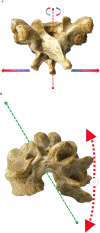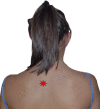Inflammatory disease of the costotransverse joints: US evaluation in 15 symptomatic patients
- PMID: 34118056
- PMCID: PMC9148345
- DOI: 10.1007/s40477-021-00589-5
Inflammatory disease of the costotransverse joints: US evaluation in 15 symptomatic patients
Abstract
The costotransverse joints (CTJs) are small arthrodial joints which articulate with the costal tuberosity on the transverse process of the thoracic vertebrae. CTJs are composed of oval-shaped facets with a major axis, vertical at the upper vertebrae and almost horizontal at the lower vertebrae. This position explains the different movements of the ribs: the cranial ribs move on the sagittal plane and the caudal ribs on the transverse plane. Movements in directions other than these usual CTJ spatial planes can cause inflammation resulting in a stinging pain in the space between the scapula and thoracic spine. We studied 15 subjects with paravertebral pain compatible with CTJ pathology. Mean age was 29 years, 11 females/4 males. In 12 patients, the non-dominant limb was affected. US imaging was carried out using linear 12 MHz and 9 MHz probes. Scanning was performed following the long axis of the rib (transverse plane) and the short axis (sagittal plane). Sagittal scanning is the method of choice for detection of possible joint effusion and comparison with undamaged joints above and below. US identified joint effusion correlating with the site of pain in all patients. Thickening of the posterior costotransverse capsular ligament was detected in six patients mainly affecting the first thoracic vertebrae. Power Doppler showed intraarticular hypervascularization in four patients. US imaging should be performed as a first-line examination in the evaluation of patients with stinging pain in the paravertebral region. US evidence of effusion within the joints is a sure sign of involvement of these structures.
Keywords: Costotransverse joint; Costotransverse joint anatomy; Costotransverse joint biomechanics; Musculoskeletal ultrasound; Thoracic back pain.
© 2021. The Author(s).
Conflict of interest statement
The authors declare that they have no conflict of interest.
Figures








References
-
- Stella SM CB (2017) Articolazioni Costotrasversarie. In: Piccin Editore P, ed. Atlante di Anatomia Ecografica e Biomeccanica dell’Apparato Muscoloscheletrico. p. 176–83.
-
- Stella SMTC, Ciampi B. Ecografia patologica muscoloscheletrica. Padova: Piccin Editore; 2018.
MeSH terms
LinkOut - more resources
Full Text Sources

